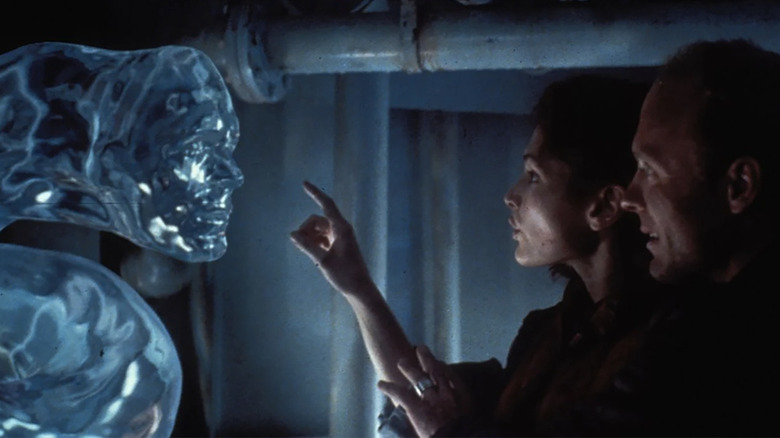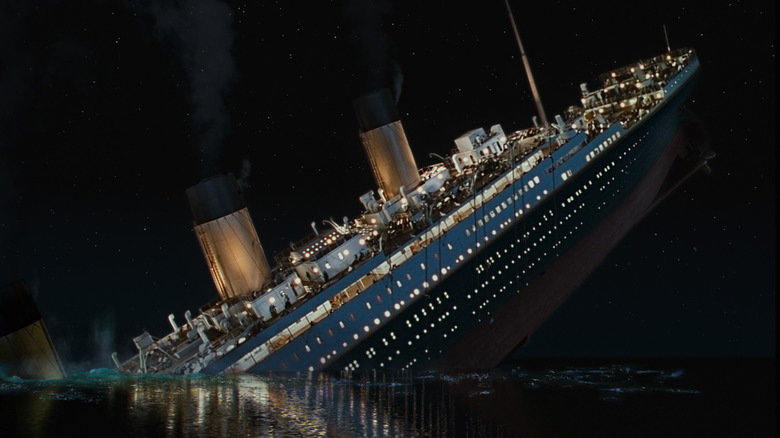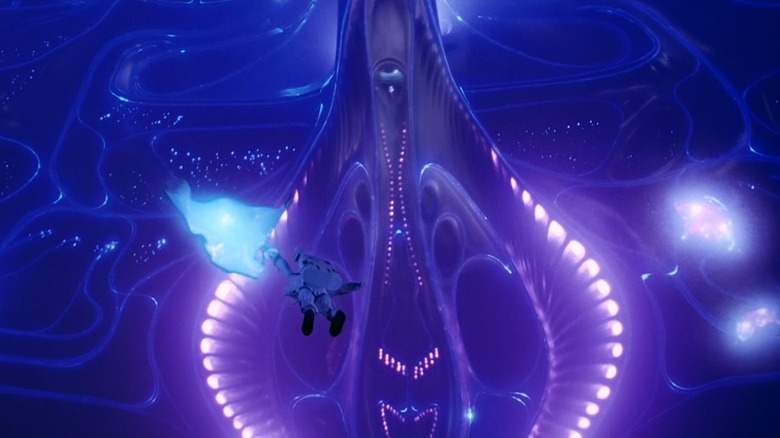James Cameron Doesn't Think He Could Have Made Titanic Without The Abyss
The long-awaited sequel "Avatar: The Way of Water" is finally hitting theaters this month, and James Cameron's immersive sci-fi adventure represents everything the acclaimed director has learned over the course of his 40-year career. Similar to George Lucas, Cameron's vision and ambition usually outpaced what was technically possible to achieve at the time. In the case of 1989's "The Abyss," the underwater sci-fi film led him to work on the cutting, bleeding edge of visual effects.
The Disney+ docuseries "Light & Magic," which chronicles the history of the special effects company Industrial, Light & Magic, highlights the arduous journey that FX artists had to embark on to create things on screen that had never been achieved by VFX before. When production began on "The Abyss," Cameron and ILM had no idea how to create the breathtaking water creature that wound up being the most memorable moment in the film, thanks to the advent of computer generated visual effects. They just knew they had a finite amount of time to figure it out, and hoped that everything would fall into place.
The limitations of time and technology forced Cameron to release "The Abyss" with a restructured ending (according to Empire) that sacrificed important themes about nuclear conflict between the United States and the Soviet Union during the Cold War. And it forced Cameron to jettison the bigger lesson of an advanced alien society judging the human race for the crimes and atrocities we've committed against each other. After "Terminator 2," Cameron went to work on a Special Edition cut of "The Abyss" that featured a blockbuster finale with another elaborate effects sequence that required even more computer generated imagery. The experience taught Cameron that bigger isn't always better, a lesson he took to heart when he went to work on "Titanic."
Technology can't replace passion
The grandeur of the RMS Titanic and the industrial world of 1912 was brought to life through the mega-budget effects work in "Titanic," setting the stage for a star-crossed love story between a nomad artist named Jack (Leonard DiCaprio) in third-class steerage and a spirited debutante named Rose (Kate Winslet) trapped in the first-class world of the stuffy elite. Loosely based on the real-life account of 17 year-old Jack Thayer, a first class passenger who managed to survive the icy waters of the North Atlantic, Cameron used past history, modern technology and sweeping melodrama to craft one of the most successful films of all time.
It's likely that all those elements would not have come together if it wasn't for Cameron's experiences making his least profitable movie, namely "The Abyss." Rabid moviegoers would sneak into theaters showing "Titanic" to catch the epic ending again, a phenomenon that definitely didn't happen during the brief theatrical run of "The Abyss" Special Edition in 1993. "Based on the technology available now, I think the ending would have worked a whole lot better," Cameron acknowledged in a past interview with Yahoo Entertainment. That being said, "The Abyss" taught Cameron a powerful lesson about the need for balanced filmmaking that greatly benefited the powerful combination of romance and adventure in "Titanic":
"I don't think 'Titanic' would have worked as well if it did if I hadn't made 'The Abyss' and learned that lesson, which is that you have to orchestrate emotionally. It's not about peaking visually, it's about peaking emotionally."
From the bow of Titanic to the oceans of Pandora
For all the saccharine sentimentality of "Titanic," the right balance was struck between Jack and Rose's fictional love story and the unthinkable tragedy that occurred when the unsinkable ship vanished under the ocean surface at approximately 2:20am on the morning of April 15, 1912. That mix of emotional and visual storytelling didn't quite hit the mark with the first "Avatar," an astoundingly lush film that chose to highlight the wonders of an alien world rather than bog down an international audience with a complicated plot. Cameron's love of nature, especially under the sea, is easily found in "The Abyss," and it steers his passion as he continues to develop the complex symbiotic relationships on the planet Pandora.
His love of bioluminescence aside, the visual similarities between both properties are obvious (notice the shot from "The Abyss" above), but Cameron sees another thread that connects them. "The common theme is that we are judged harshly by a more evolved alien culture," he told "Jurassic World" director Colin Trevorrow in the latest issue of Empire magazine. Cameron just reversed the perspective where the human race is the alien invader in the "Avatar" universe, instead of the ones being invaded.
Cameron wanted "The Abyss" to be his version of "The Day The Earth Stood Still," which would work as "a comment on how an alien super-intelligence might judge rather harshly the way we mistreat each other and our beautiful world." There's a subtle commentary in "Titanic," as well, that serves as a pitstop between both of Cameron's explorations of our oceans and the aquatic lifeforms in "Avatar: The Way of Water." The actual ship, the RMS Titanic, was perhaps the greatest symbol of the Second Industrial Revolution, as the largest moving object ever made by man. Cameron used the sinking of the Titanic to show our hubris in thinking that we had constructed something that was impervious to nature. Obviously, the iceberg thought otherwise.


